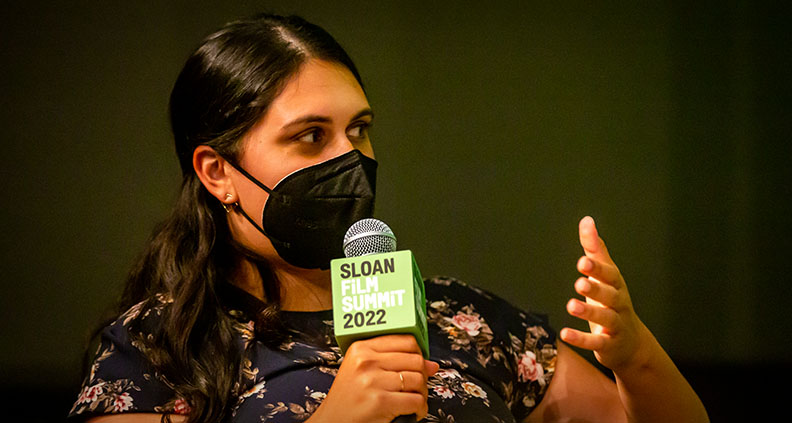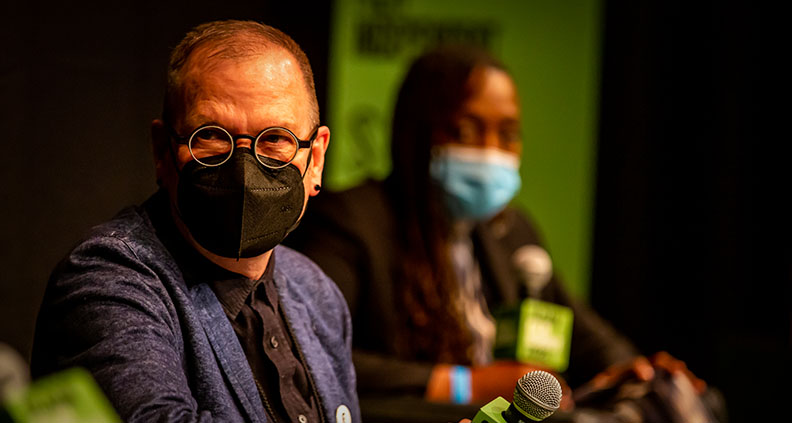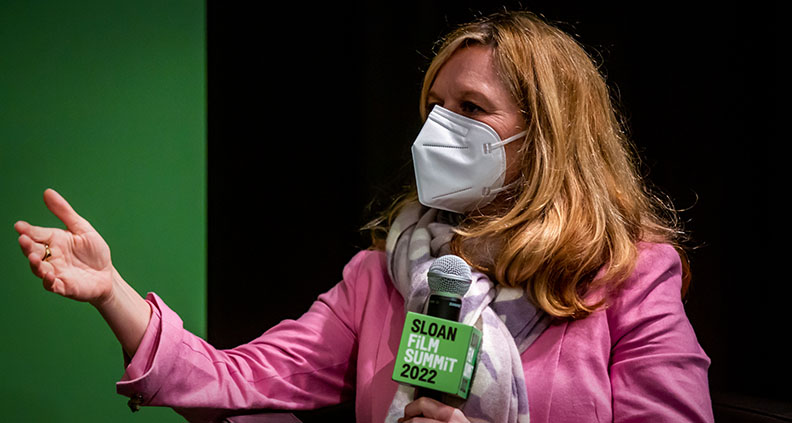Epidemiologists Unpack HBO’s ‘How to Survive a Pandemic’
One of the the most reassuring elements on display at the 2022 Sloan Film Summit—which took place earlier this month, April 8-10, in LA’s Little Tokyo neighborhood—was that of the event’s omnipresent COVID-19 safety procedures. Regular testing for all staff and attendees! Indoor mask requirements! Limited indoor event seating! That’s right: everything was strictly by the book, which is exactly what you want when discussing the pandemic’s global spread with three of the nation’s most renowned epidemiologists, Illinois Department of Public Health Director Dr. Ngozi Ezike, USC clinical professor of population and public health sciences Dr. Jeffrey Klausner and UCLA professor of epidemiology Dr. Anne Rimoin.
Joining this esteemed panel onstage at the Tateuchi Democracy Forum—masked and spaced a doctor-recommended six feet apart, of course—was filmmaker David France, whose newest project, How to Survive a Pandemic, had just screened as the Summit’s Closing Night film. Moderating the panel was New York Times reporter Soumya Karlamangla.
Watch the full Q&A here and see the highlights below:
Karlamangla began by asking France, who started shooting the film—a sort of thematic successor to his acclaimed 2012 AIDS crisis doc How to Survive a Plague—in April 2020, “What sort of story did you think you were going to tell?”
“I knew I wanted to report on the vaccine,” said France, whose film ultimately chronicles the COVID-19 vaccine’s development, resistance and problematic rollout. “It was my fixation. I had been dreaming about it and calling people up every day to gossip about it.” Eventually he came to the realization that if he was going to spend all day every day thinking about the virus anyway, “We might as well produce something productive out of it,” he said.
Optimistically, France thought How To Survive a Pandemic might be the story of “citizens intervening synergistically” to confront a common existential health threat, as the rallying of support behind AIDS had been. But while France said he thought that many of the lessons learned during that earlier epidemic had been satisfactorily applied by the medical community to their work with COVID, the public’s understanding of researchers’ work was lagging far behind.

“If everyone watched this movie, I think there would be far less vaccine hesitancy,” said Karlamangla. Ezike agreed. “Communication has been our number one issue,” she said, saying that her public health department comms team in Illinois went from one person to 12 full-time employees as the virus began to ramp up. It was necessary, she quickly found, to adjust the pitch depending on who was listening.
“There were too many populations and sub-populations that needed to be addressed,” requiring her team to think about who was delivering the message and how to each individual subgroup. “It’s not just about talking, it’s about listening,” said Dr. Klausner, adding, “We’ve done a terrible job in this country of scientific education” and called for a greater emphasis on STEM education in schools.

“People in public health tend to be pretty optimistic and even naive,” said Rimoin, saying that she was shocked at the severity of the divide between those who immediately embraced the vaccine and those who did not, though she did note: “Pandemics are inherently political. To some degree, this was always going to happen.” She added that the delay in getting the vaccine out to under-resourced communities only exacerbated vaccine hesitancy.
Speaking to the concerns of some vaccine skeptics, Ezike stressed that citizens should understand that “[They’re] not guinea pigs—they’re an important part of the scientific process,” observing that 90% of people in her area being admitted to the hospital for COVID have not been vaccinated.

The bifurcated social and political response to the vaccine accounted for How to Survive a Pandemic‘s diptych-like approach, said France. “That did divide the film in two parts,” he said—one following the vaccine’s development, another its challenged rollout—noting with dismay a film review that suggested he should’ve ended the film on the triumphant note of the vaccine having been successfully developed, rather than telling the whole truth of the matter.
“It’s not going away from planet Earth,” lamented Dr. Klausner, “[COVID] will continue to circle around large animal reservoirs and make make the leap to humans,” saying that scientists now are just trying to determine if the virus will remain a major public health threat or be reduced to a perpetual—though manageable—public health foe like influenza or the common cold. Rimoin noted that the development of new variants is “a direct result of vaccine hesitancy.”
France says that education is the primary reason why he made the film. “We needed to to see it,” he said, of the process of developing the COVID-19 vaccine. “Hopefully in seeing it, it demystifies it in some way.” He then used the opportunity to praise the Sloan Film Program for its efforts to help bridge the gap between science and pop culture.
Ultimately, no one—not even the scientists—know what will happen with COVID. “People want to read the end of the book,” said Dr. Rimoin. But the end of the book has yet to be written, the experts agreed. “That’s something that’s really hard to communicate to people,” she said.
But films like How to Survive a Pandemic are, quite possibly, the first step.
The 2022 Sloan Film Summit happened April 8-10 in Los Angeles. Stay tuned to sloanfilmsummit.org for videos, blog recaps and more. Follow our coverage on Film Indepenent’s Twitter, Facebook and Instagram.
(Header: Dr. Ngozi Ezike, by Jay Young Photography